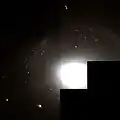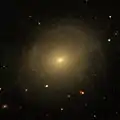| NGC 7585 | |
|---|---|
 Hubble Space Telescope (HST) image of the galaxy | |
| Observation data (J2000 epoch) | |
| Constellation | Aquarius |
| Right ascension | 23h 18m 01.3s[1] |
| Declination | −04° 39′ 01″[1] |
| Redshift | 0.011805 ± 0.000003 |
| Heliocentric radial velocity | 3539 ± 1 km/s[1] |
| Distance | 145 million light years |
| Apparent magnitude (V) | 11.4[2] |
| Characteristics | |
| Type | (R')SA(s)0+ pec[1] |
| Apparent size (V) | 2.3′ × 2.0′[1] |
| Other designations | |
| MCG -01-59-015, PGC 70986,[1] Arp 223[1] | |
NGC 7585 is a lenticular galaxy with a peculiar shape resulting from an interaction between two galaxies. It is located 145 million light years away in the constellation Aquarius which, given its apparent dimensions, means that NGC 7585 is about 100,000 light years across. It was discovered by William Herschel on September 20, 1784.[3]
Characteristics
NGC 7585 is a lenticular galaxy with shells. The disk of the galaxy is also present and distinct from the shells. The shells are irregular and have radial and loop form, and one of them looks like a faint outer arm. The shells are probably the result of a merger that took place over a billion years ago. The shells are bluer than the rest of the galaxy and suggestive of a spiral galaxy taking part in a merger, while other features seem to be part of the accreted galaxy.[4] The upper limit of the molecular gas mass based on CO imaging is 107.5 M☉.[5]
Nearby galaxies
Two galaxies appear near NGC 7585. NGC 7576 is located 10.7 arcminutes southwest of NGC 7585, while NGC 7592 is located 15.2 arcminutes to the northeast. NGC 7576 is at a similar redshift with NGC 7585, but its normal shape indicates it has not interacted recently with NGC 7585. On the other hand, NGC 7592 appears disturbed, however it has double the redshift.[4]
Gallery
 NGC 7585 by Hubble Space Telescope
NGC 7585 by Hubble Space Telescope NGC 7585 by SDSS
NGC 7585 by SDSS
References
- 1 2 3 4 5 6 7 "NASA/IPAC Extragalactic Database". Results for NGC 7585. Retrieved 2020-11-03.
- ↑ "Revised NGC Data for NGC 7585". spider.seds.org. Retrieved 25 November 2018.
- ↑ Seligman, Courtney. "NGC 7585 (= PGC 70986)". Celestial Atlas. Retrieved 19 November 2018.
- 1 2 McGaugh, Stacy S.; Bothun, Gregory D. (October 1990). "Stellar populations in shell galaxies". The Astronomical Journal. 100: 1073. Bibcode:1990AJ....100.1073M. doi:10.1086/115580. hdl:1903/8712.
- ↑ Ueda, Junko; Iono, Daisuke; Yun, Min S.; Crocker, Alison F.; Narayanan, Desika; Komugi, Shinya; Espada, Daniel; Hatsukade, Bunyo; Kaneko, Hiroyuki; Matsuda, Yuichi; Tamura, Yoichi; Wilner, David J.; Kawabe, Ryohei; Pan, Hsi-An (12 August 2014). "Cold molecular gas in merger remnants. I. Formation of molecular gas disks". The Astrophysical Journal Supplement Series. 214 (1): 1. arXiv:1407.6873. Bibcode:2014ApJS..214....1U. doi:10.1088/0067-0049/214/1/1. S2CID 716993.
External links
 Media related to NGC 7585 at Wikimedia Commons
Media related to NGC 7585 at Wikimedia Commons- NGC 7585 on WikiSky: DSS2, SDSS, GALEX, IRAS, Hydrogen α, X-Ray, Astrophoto, Sky Map, Articles and images